This piece is about spending time alone. And first, a bit on my experience walking Menorca’s GR223 and why it’s a damn fine walk. The most practical aspects of the walk; daily stages, numbers, and links to stage maps, can be found at the end of the piece.
This walk is part of my current walking season. Before this, I walked the GR221 in Mallorca. After this I will walk Madeira’s thru-hike.
I’m writing this from a quiet café in Maó. Two days ago, I completed Menorca’s Cami de Cavalls. I started here, in the islands’ capital Maó (also Mahón), and 9 days later, after walking 185km of (mostly) coastline, I had circled the island and walked back into the city. Menorca is the gentle island. (I stole this line from a 1960s BEA airline advertisement for flights to Menorca that I saw at the interesting Museo de Menorca).
Flying to Menorca from Palma is a delightful experience. A separate domestic flights terminal with flights to Ibiza and Menorca, mostly Spanish people, much more quiet. No Burger King-, Starbucks-, Golden Arches-ness crap. Just one stall with coffee, water, and pan con tomato, sobrasada, jamon - yum.
A half-filled propellor plane, brought me to Maó airport in about 20-30 minutes. The taxi ride from the airport to the city centre takes 9(!) minutes. About 90 minutes after departing from Palma airport, I was in my hotel room in Maó.
Naturally, having recently walked the GR221 in Mallorca, I couldn’t help but make comparisons between the two islands. Difficult, I soon found out - Mallorca and Menorca are different in many ways.
Well yeah, they’re obviously family. Sisters, I’d even say. But they’re the kind of sisters you see from a distance or maybe meet once - you know they are related, sure. But spend a bit more time with them, and you quickly realise that they are so clearly different. At some point, you might even begin to suspect they have different fathers.
Menorca is quiet, tranquil, flat, calm. The landscapes, even the people, feel gentler. Mallorca, by contrast, feels big, rough, sometimes rude and a little trashy on the weekends. Menorca radiates friendliness, softness, kindness, innocence. She’s a little shy, likes to stay in the background. She’d rather stay (relatively) undiscovered. She’s not trying to impress you. And that, ironically, is kind of attractive to me.
Oh, and there’s a little brother too. Ibiza is, I imagine, the hippie sibling - who I haven’t met. Not sure I will any time soon, I heard he has some childhood trauma’s to resolve.
— Alright, enough with the extended metaphor. Pathetic fallacy and all that…

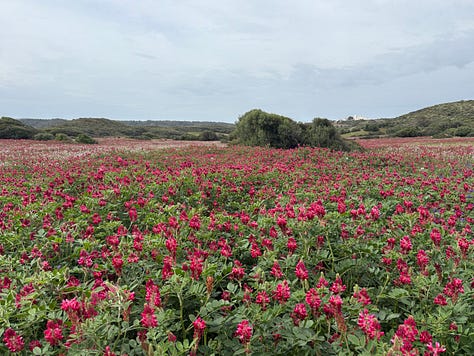
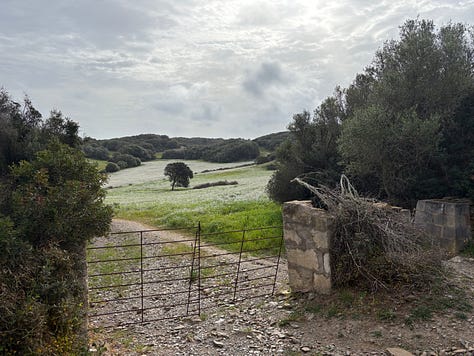
The “Cami de Cavalls” translates from Catalan as “Way of Horses”. The path dates back to the 14th century, originally used guards on horses patrolling the islands perimeter against potential threats coming from the sea.
It’s a damn fine walk. April is a good month to walk it - temperatures pleasant, few tourists. I did get some (intense) rain, and many restaurants and accommodations are still closed. You can tell that many of the towns you walk through come alive in summer, full of people on all-inclusive holidays.
To me, the diversity of landscapes stood out. Wild, martian-like landscapes around Far de Favàritx. Lagoons, wetlands and salt flats in the Albufera des Grau national park. Naturally formed rias - fjord-like bays that are used as harbours, such as in Maò (one of the largest natural harbours in the world) and Fornells. Dramatic cliffs around Cala Morell (I loved this place). The old capital Ciutadella, with yet another dramatic lighthouse Far de Punta Nati just to its north.
And then you get to the southern coast; sandy coves, pine trees, and turquoise water that feel Greek. All of it is frequently alternated by scrubby inland stretches, with dense maquis vegetation. Big, wide skies. Many dry stone walls, olive, fig, and carob trees giving a hint of big sister Mallorca.
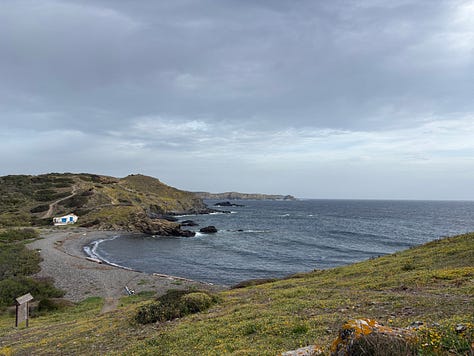
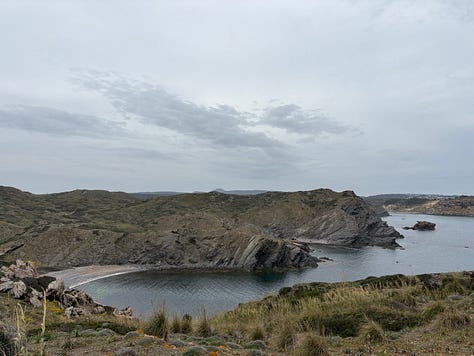


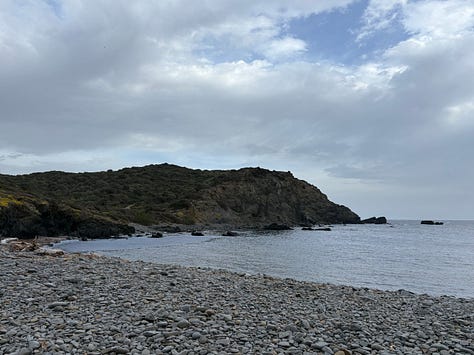

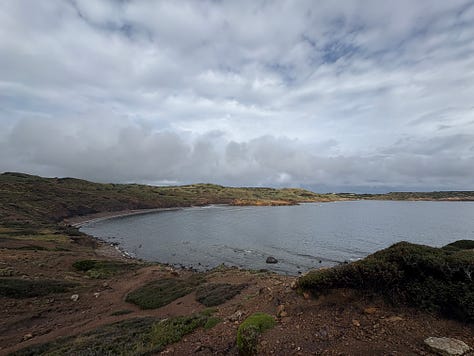
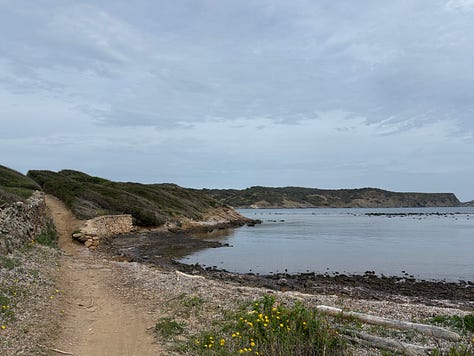
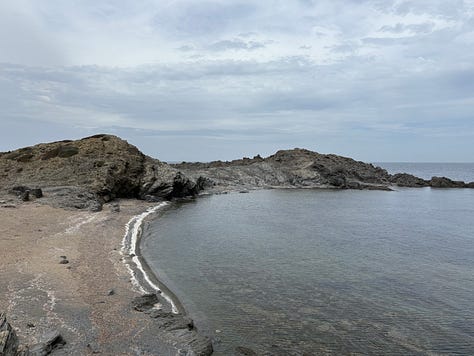
My goal here isn’t to decide whether walking Alone or walking Together is better. My goal is to reflect on the difference of the experience, for me. My thoughts are probably not your thoughts. And, spoiler: there’s no better. Both are great. What I AM saying is that you should do your own walks. Alone and together. Doing so, you will build some capacity to be alone.
I laughed when I read this message upon waking up. Classic her, sending questions like these at this time. Great way to start her (busy) work week.
Her question stayed with me as I was walking that day, alone. This question, and my anticipation of shifting from me walking alone to me walking together for the last days of the walk got me thinking about both experiences. And more broadly, about Aloneness, Loneliness, Solitude and Togetherness. And about our capacity to be alone.
During my walk that day I chatted to my friend and she told me about her intentional Sundays alone:
“By 6ish I start to want some company,” she wrote. “Just for a stroll, let’s say.”
Her question and struggle come from a common place. She’s not alone. We, our society, are lacking this capacity to be alone, and it’s a pity.
Aloneness and solitude are not the same as loneliness. Being alone, is a physical state. Solitude and loneliness are states of mind. The first a good state, the second not. Having capacity to be alone means being able to find Solitude in being alone. Not being lonely. In other words, having the capacity to be alone is being able to walk the fine line of Solitude, without falling in the deep ravine of Loneliness.
Arthur Schopenhauer, the 19th-century philosopher, described loneliness as “an emptiness”, “to desire an absent want” and solitude as “to take great pleasure in your own company,”.
Solitude is a thin line that’s difficult to balance on. Attention helps you balance, distraction pushes you off.
One problem is that we are simply untrained at being alone. Aloneness feels optional. In every quiet moment, we reach, scroll, refresh, check. We treat aloneness like a problem, something to fear. Aloneness feels like a lack, a gap that must be filled quickly, a discomfort we cover with instant distraction.
We’re losing our capacity to be alone.
I often feel the need to explain why I choose to walk alone. It’s similar to having to explain why you’re not drinking alcohol at a party. My friend asked me explicitly about aloneness while walking (which I appreciate a lot), but there are many people that ask more implicitly.
This doesn’t mean we don’t need or crave solitude. We do silent retreats, we meditate in our yoga classes, we go off-grid for a week to “detox”.
So have I. Over the past years, I’ve tried to build my capacity to be alone. Mindfulness, yoga, meditation retreats. I’ve practiced them on and off, and they had their effects, also on my attention and my capacity to be alone. But I’ve found walking, and specifically walking alone, most helpful at improving my capacity to be alone. Walking might be the best meditation I know. It does what meditation promises: a clear, calm state. Blissful.
On a good walk, I estimate my capacity to be alone to be about 65%/35%. With 65% of the times feeling more towards blissful Solitude than uncomfortable Loneliness.
And still, it’s a fine line. I feel my friend’s ongoing tension, the pull between wanting to be alone and craving togetherness:
When I walk alone, I crave walking together.
When I walk together, I crave walking alone.
We need to develop the capacity to be alone. To learn to find comfort in aloneness. To let the mind be quiet, with our own thoughts. Finding comfort in aloneness, stop looking for escapes and distractions. To understand the aloneness you must be with it, uninfluenced.
Why?
“I love to be alone. I never found the companion that was so companionable as solitude.”
Henry David Thoreau

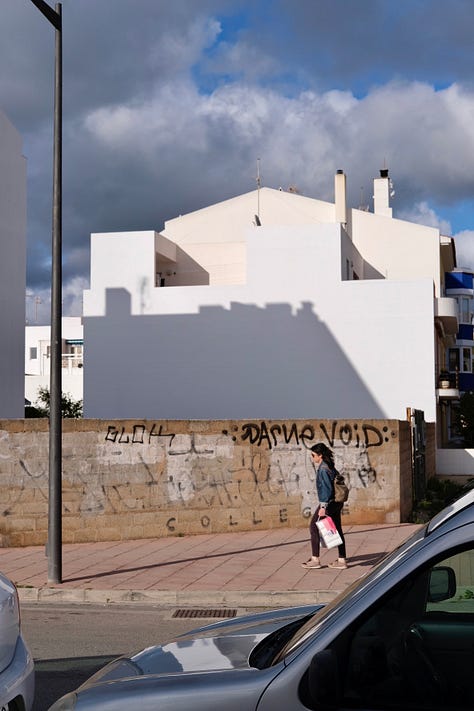
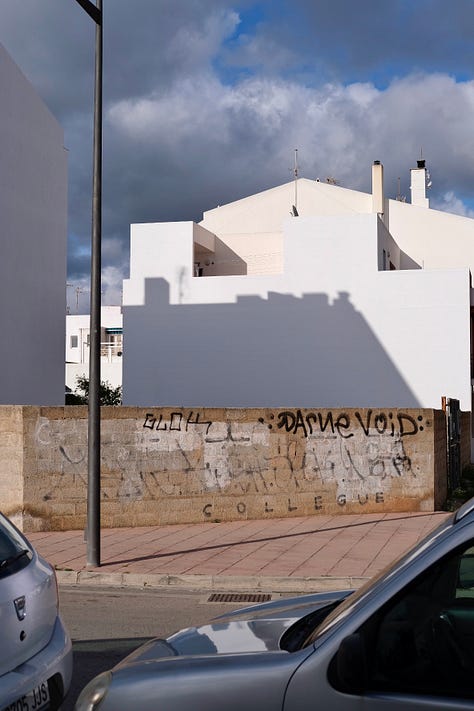
In the state of aloneness you get to know yourself. Aloneness allows for a state where opinions of others don’t matter. Non-conformity. No others to cling to, no paying attention to what you should be or should not be, no distractions. A chance to think freely without distraction and outside influences, let your mind wander.
Being less susceptible to the influence of others brings confidence. Confidence in your ability to do things that “owe nothing to any consensus or to the fashions which pass as law”. Whoever said it, they were right.
Aloneness also brings creativity; a heightened sensitivity to new ideas and vague questions that arise from within, and that might sound “stupid”, “bad”, or unpopular to others. Ideas that might not even come up, or would be dismissed too quickly. It helps you do groundbreaking, quality work, whatever that means.
In Bob Dylan’s words: “To be creative you’ve got to be unsociable and tight-assed.” Creativity needs space.
Pablo Picasso said it differently: “Without great solitude, no serious work is possible.” They agreed.
If we create the capacity to be alone, we build a stronger mind, less influenceable and disturbed. Confidence. And a mind that is capable of being creative. Creativity driven by you, internal processes, not things or people around you.
And walking, alone, in nature, is the best way to do this. Go!
— Felipe 💚
A few more practical GR223 practicalities for the few interested in them….
GR223 daily stages
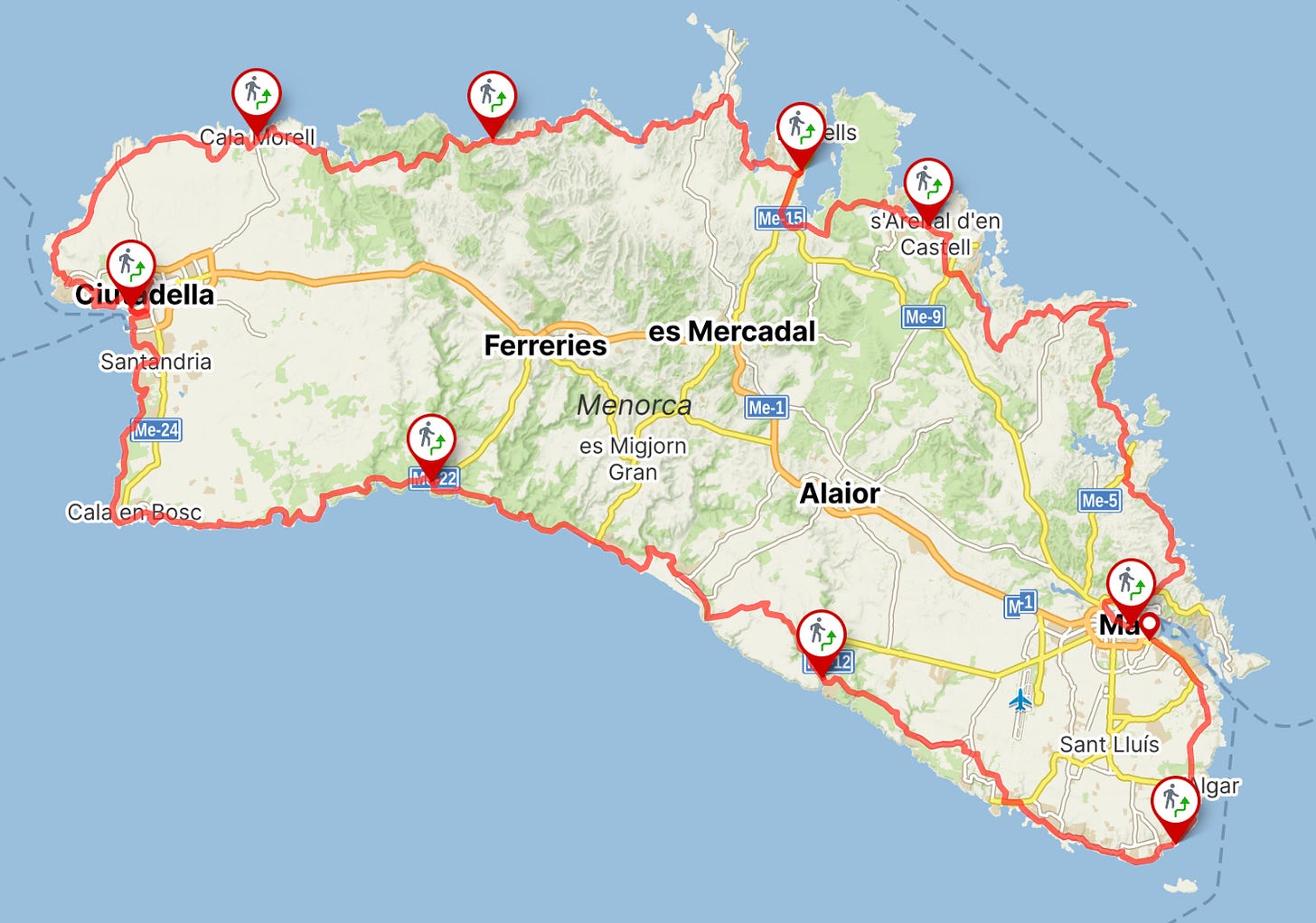
Including distance, elevation covered, and link to stage map (see complete elevation profile in the linked stage maps)
Mahon → Punta Grossa - 35km - 730m
Punta Grossa → Fornells - 11km - 115m
Fornells → Ets Alocs - 20km - 637m
Ets Alocs → Cala Morell - 17km - 278m
Cala Morell → Ciutadella - 19km - 304m
Ciutadella → Cala Galdana - 31km - 250m
Cala Galdana → Cala en Porter - 24km - 502m
Cala en Porter → Punta Prima - 20km - 213m
Punta Prima → Mahon - 12km - 125m
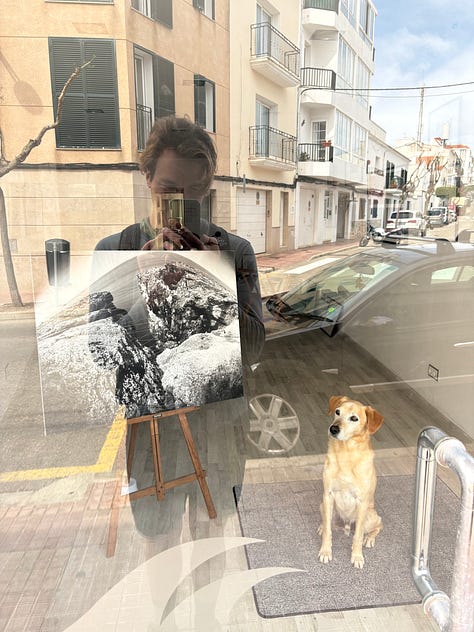
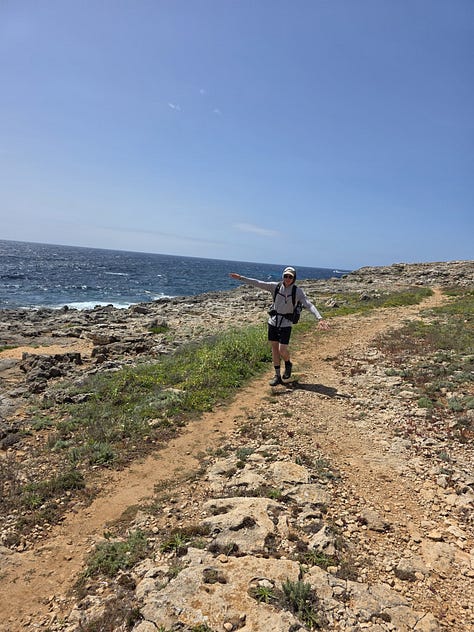
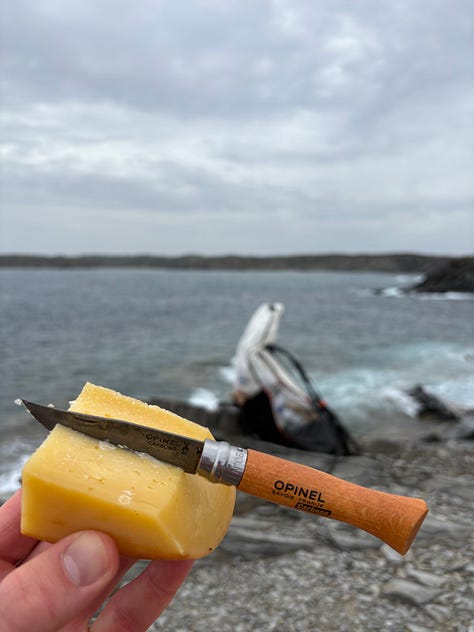
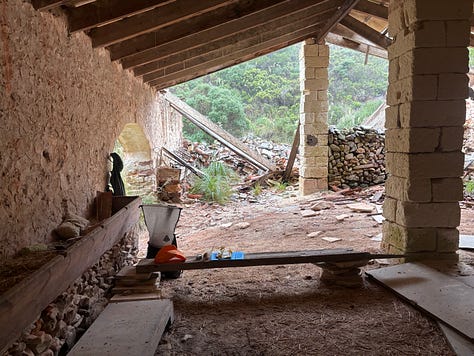
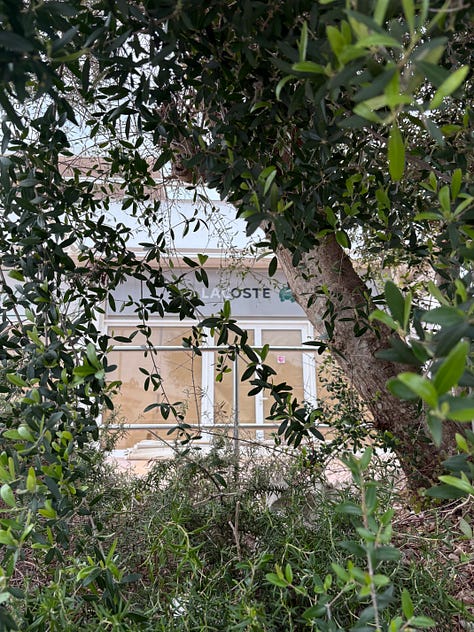
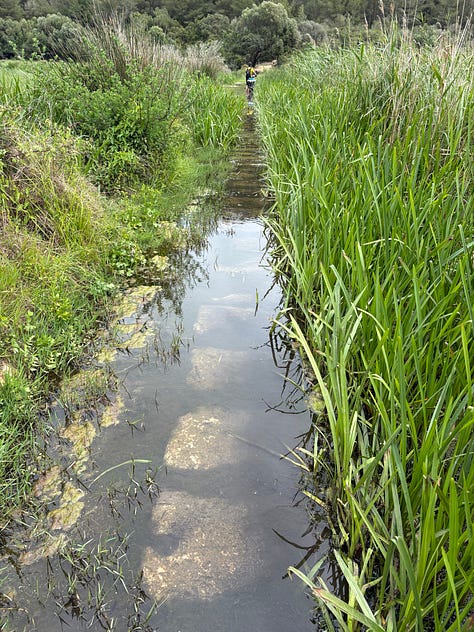






'Aloneness feels optional' 🧡
echt prachtig om te lezen felipe… zowel over het uiterlijke, als over het innerlijke landschap… mooie reis maak jij van je leven!
ps. zie ik je niet in les marecottes deze zomer?